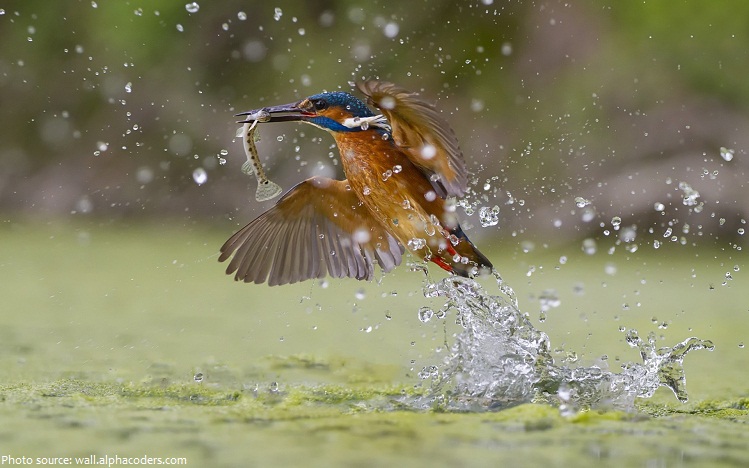Kingfishers are known for their looks
Kingfishers large body bills, long and thick; and striking markings and colors. The majority of kingfishers are adorned with feathers that are bright blue or turquoise, green gold, red or. There are feathers with flecks or stripes, dashes or speckles.
The dagger-shaped bill can appear too long or large for the other bird, yet it’s ideal to capture food. The majority of kingfishers have shorter legs and robust feet because they spend most of their time perched on a twig, stalk or twig and keeping an eye on the water for dinner. Despite being large birds, kingfishers can be fast flyers. Certain species, such as pied kingfishers, even flap their wings in a way to fly above the water.
Kingfishers are known to be clean and fresh
by bathing in the water and then sitting under the sun’s rays to dry off and condition their feathers. A few utilize the wings of their sexes to scratch and scrub their heads. They also keep their impressive bill free of dirt by scraping it against a tree until they are sure they are satisfied that their bill remains in good shape.
Kingfishers make a variety of calls that are used to announce their territory, alert the birds around them, as well as even communicate with their mates and chicks. These include screaming, screams and clicks whistles chuckles rattles, and chirps. White Birds The most well-known call however is that of the laughing Kookaburra it’s a “kooa haha haha” that makes it sound like someone is laughing. You may have heard this call in films set in the jungles in Africa or South America. However, the laughing kookaburra actually is indigenous to Australia!
Kingfishers are territorial birds that are territorial.
They mark out a territory that has good sources of food, comfortable perches, and a secure place to rest in the evening. They’re most active in the morning and evening hours, however, if it’s not excessively hot they could also be hunting in the afternoon.
A lot, including the common kingfisher and azure kingfisher, are piscivores. Kingfishers are excellent in catch prey. They sit on top of the stream, river, or lake, and gaze at the waters, waiting for a fish to appear in the water. Some do go out to hunt food in the soil, for example, the kingfisher with shovel-billed bills and the kingfisher that is banded.
The majority of kingfishers have great vision and can see through the water, even adjusting to refraction, which could cause a fish to appear further away from the water than it actually is. The sacred kingfisher is able to see prey from as far as 100 feet (90 meters) away! The bird bursts out then dives to grab the fish and then returns back to the perch in order to prepare its dinner.
The kingfisher smacks the fish with the perch,
breaking the bones, and allowing for easier swallowing. Then, it juggles the fish with its beak and then swallows the fish head-first to ensure that its throat is not scratched by the scales as it goes down.
However, kingfishers that consume a lot of fish, also consume other food items at times, including snails, crabs, crayfish, and Frogs. Kingfishers living in grasslands, forests, and deserts have a distinct diet, consuming an array of reptiles, spiders, insects, and even small mammals which they hunt by spotting the prey from their perch, before sprinting out to take the prey up.
Snakes can be found available for consumption The blue-winged Kookaburra, for instance, is often referred to as an expert at hunting snakes, by grabbing one’s head before smashing it against a tree or rock to eliminate it. The process of swallowing it can be tricky the snake falls down the head first, and the rest of its body is hung out of the kookaburra’s mouth as it’s being taken in bit by bit!
The majority of kingfishers are single they only join
with a partner during the breeding season. Blue-winged and laughing Kookaburras reside in families made comprised of two females and a male as well as their older offspring who help create young chicks. It is also unusual the fact that the “helpers” are mostly males. Also, the kookaburras (along with other species) have chicks whose uncles are the ones who feed and care for the chicks, not their aunts!
Kingfishers don’t make nests out made of sticks or even plants. Instead, they build nests in burrows which they dig into trees, dirt banks, or even old termite mounds. A pair of males and females work together to build the burrow. They alternate digging the soil using their feet. The burrow will take between three and seven days to construct. It usually slopes upwards to keep it from flooding.
It generally ranges from 3 to 6.5 inches (1 up to 2 meters) in length. The record-setting length is an enormous 28,050-foot (8.5-meter) burrow that was dug by a pair of massive Kingfishers. The burrow’s end is an enclosed nesting area that measures approximately 8-12 inches (20 to 30 centimeters) across as well as between 6 and 7 inches (15 -17 centimeters) high.
The nesting chamber is where eggs are laid,
and the chicks are raised. In the beginning, parents take food right to the nesting space and as the altricial chicks develop and develop, they begin to walk towards the entrance of the burrow to be with the adults. They eventually settle at the entrance, or perhaps in a nearby tree and wait to be fed. When they are fledging, it may be anywhere from a few days to several weeks, depending on the species. Then, the chicks begin looking for and eating the food they eat.


